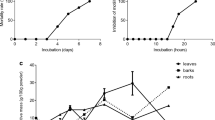Abstract
An ultrastructural study of microfilariae of Wuchereria bancrofti was performed after treatment in vitro and in vivo with diethylcarbamazine citrate (DEC). The morphological alterations produced by treatment in vitro with 5 µg/ml of DEC were the loss of microfilarial sheaths and lysis of the cytoplasm, with the destruction of all organelles and the formation of several vacuoles, the contents of which presented various degrees of electron-density, or showed an empty appearance. Some of these vacuoles seemed to be extruding from the cytoplasm as apoptotic bodies and others presented organelles inside. Similar alterations were observed after in vivo treatment. At 40 min after treatment of a microfilaremic individual with DEC, almost all microfilariae observed had lost their sheaths; and, in some of them, remains of the microfilarial sheath on the larval surface could be detected. Numerous vacuoles were observed, mainly in the hypodermis and somatic cells, showing organelles inside or an empty appearance. Condensed chromatin was also observed in some somatic cells. At 1 h after treatment of a microfilemic individual with DEC, microfilariae presented drastic morphological alterations, with large vacuoles within somatic cell cytoplasm and complete lysis of all cellular organelles. Therefore, both treatments with DEC in vitro and in vivo had a direct mechanism of action on the microfilariae of W. bancrofti, including organelle damage and apoptosis.


Similar content being viewed by others
References
Davies P, Bailey PJ, Goldenberg MM, Ford-Hutchinson AW (1984) The role of arachidonic acid oxygenation products in pain and inflammation. Annu Rev Immunol 2:335–57
Devaney E, Howels RE (1979) The exsheathment of Brugia pahangi microfilariae under controlled conditions in vitro. Ann Trop Med Parasitol 73:227–233
Florêncio MS, Peixoto CA (2003) The effects of diethylcarbamazine on the ultrastructure of microfilariae of Wuchereria bancrofti. Parasitology 126:551–554
Hawking F (1979) Diethylcarbamazine and new compounds for the treatment of filariasis. Adv Pharmacol Chemother 16:129–194
Hawking F, Laurie W (1949) Action of hetrazan on filariasis and onchocerciasis. Lancet 2:146–147
Hawking F, Sewell P, Thurston JP (1948) Mode of action of hetrazan in filariasis. Lancet 2:730–731
Johnson P, Mackenzie CD, Denham DA, Suswillo RR (1988) The effect of diethylcarbamazine on the in vitro serum-mediated adherence of feline granulocytes to microfilariae of Brugia pahangi. Trop Med Parasitol 39:291–294
Kanesa-thasan N, Douglas JG, Kasura JW (1991) Diethylcarbamazine inhibits endothelial and microfilarial prostanoid metabolism in vitro. Mol Biochem Parasitol 49:11–20
Maizels RM, Denham DA (1992) Diethylcarbamazine (DEC): immunopharmacological interactions of anti-filarial drug. Parasitology [Suppl] 105:S49–S60
McLaren DJ (1972) Ultrastructural studies on microfilariae (Nematoda: Filaroidea). Parasitology 65:317–332
Peixoto CA, Alves LC,Brayner FA, Florêncio MS (2003) Diethylcarbamazine induces loss of microfilarial sheath of Wuchereria bancrofti. Micron 28:381–385
Piessens WF, Beldekas M (1979) Diethylcarbamazine enhances antibody-mediated cellular adherence to Brugia malayi microfilariae. Nature 282:845–847
Rajan TV, Porte P, Yates JA, Keefer L, Shultz LD (1996) Role of nitric oxide in host defense against an extracellular, metazoan parasite, Brugia malayi. Infect Immun 64:3351–3353
Rajan TV, Shultz LD, Babu S, Doukas J, Greiner D, Porte P (1998) Diethylcarbamazine (DEC) does not induce nitric oxide (NO) synthesis. Exp Parasitol 88:217–222
Schardein JL, Lucas JA, Dickerson, CW (1968) Ultrastructural changes in Litomosoides sigmodontis microfilariae in gerbils treated with diethylcarbamazine. J Parasitol 54:3511–3518
Taylor MJ, Cross HF, Mohammed AA, Trees AJ, Bianco AE (1996) Susceptibility of Brugia malayi and Onchocerca lienalis microfilariae to nitric oxide and hydrogen peroxide in cell-free culture and from IFN-γ activated macrophages. Parasitology 112:315–322
Weiner DJ, Soulsby EJL (1982) Litomosoides carinii: effect of diethylcarbamazine in microfilaremias of Mastomys natalensis harbouring old infections, new infections, and transfused microfilariae. J Parasitol 68:1105–1109
Acknowledgements
This work was supported by the Fundação Oswaldo Cruz (FIOCRUZ), the Conselho Nacional de Desenvolvimento Científico e Tecnológico (CNPq project 470038/2001) and FIOCRUZ/FIOTEC/FUNASA (project 268,sub-project 17).
Author information
Authors and Affiliations
Corresponding author
Rights and permissions
About this article
Cite this article
Peixoto, C.A., Rocha, A., Aguiar-Santos, A. et al. The effects of diethylcarbamazine on the ultrastructure of microfilariae of Wuchereria bancrofti in vivo and in vitro. Parasitol Res 92, 513–517 (2004). https://doi.org/10.1007/s00436-004-1081-0
Received:
Accepted:
Published:
Issue Date:
DOI: https://doi.org/10.1007/s00436-004-1081-0




